As summer is swiftly approaching, JBL does not miss a beat. With the Boombox 3 WiFi, the American manufacturer aims to provide the ultimate portable speaker, equally capable of creating a gentle musical ambiance for a picnic in the park, as it is in producing powerful sound for a beach party lasting into the night.
The Boombox 3 WiFi sits at the pinnacle of a successful line of portable speakers, including the JBL Clip 4, JBL Flip 6, JBL Charge 5, and JBL Xtreme 3, and stands out with its notably higher maximum volume, better balance, and a record-breaking 24-hour battery life. This exceptional speaker also has WiFi connectivity — just like the new JBL Charge 5 WiFi — supporting streaming protocols such as AirPlay, Chromecast, Spotify Connect, Alexa multiroom, and even Dolby Atmos.
To top it all off, the Boombox 3 WiFi comes equipped with microphones to analyze the surrounding sound atmosphere and adapt its sound signature accordingly.
JBL Boombox 3 WiFi Specifications
| Model | JBL Boombox 3 WiFi |
|---|---|
| Dimensions | 48.2 cm x 20 cm x 25.7 cm |
| Sound Power | 200 watts |
| Advertised Battery Life | 24 hours |
| Built-in Microphone | Unknown |
| Bluetooth Version | 5.3 |
| Weight | 6790 grams |
| Protection Rating | IP67 |
| Price | $399 |
JBL Boombox 3 WiFi Design
The JBL Boombox 3 WiFi maintains the characteristic style of JBL’s portable speakers, a bulging cylinder covered with a reinforced acoustic fabric with large mesh. The dimensions are quite significant, with no less than 48 cm in length and 26 cm in height, roughly twice the size of the JBL Xtreme 3 or three times that of the Flip 6. These dimensions are necessary to maintain a pleasant tonal balance at high volumes.
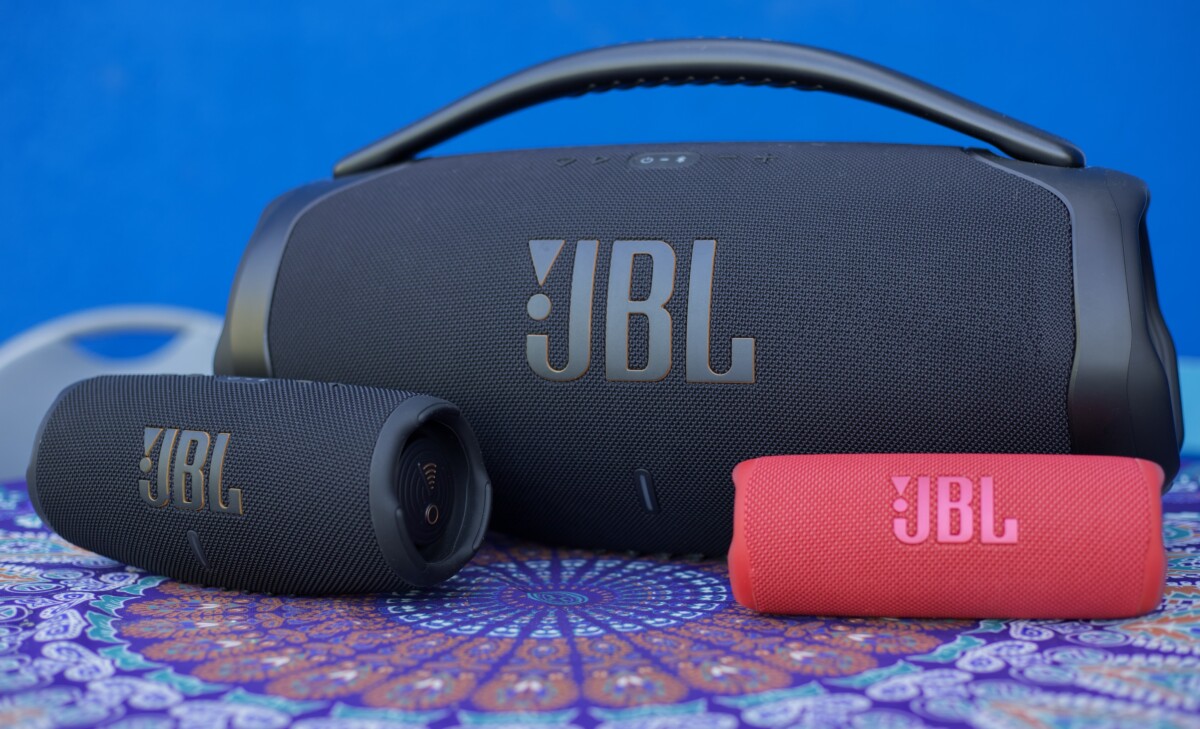
The build quality is beyond reproach, with each component assembled with impeccable precision. The carrying handle of the Boombox is made from brushed aluminum, with a molded anti-slip structure. The control buttons are located on the top of the speaker and slightly offset towards the front, so the carrying handle does not interfere with their use.
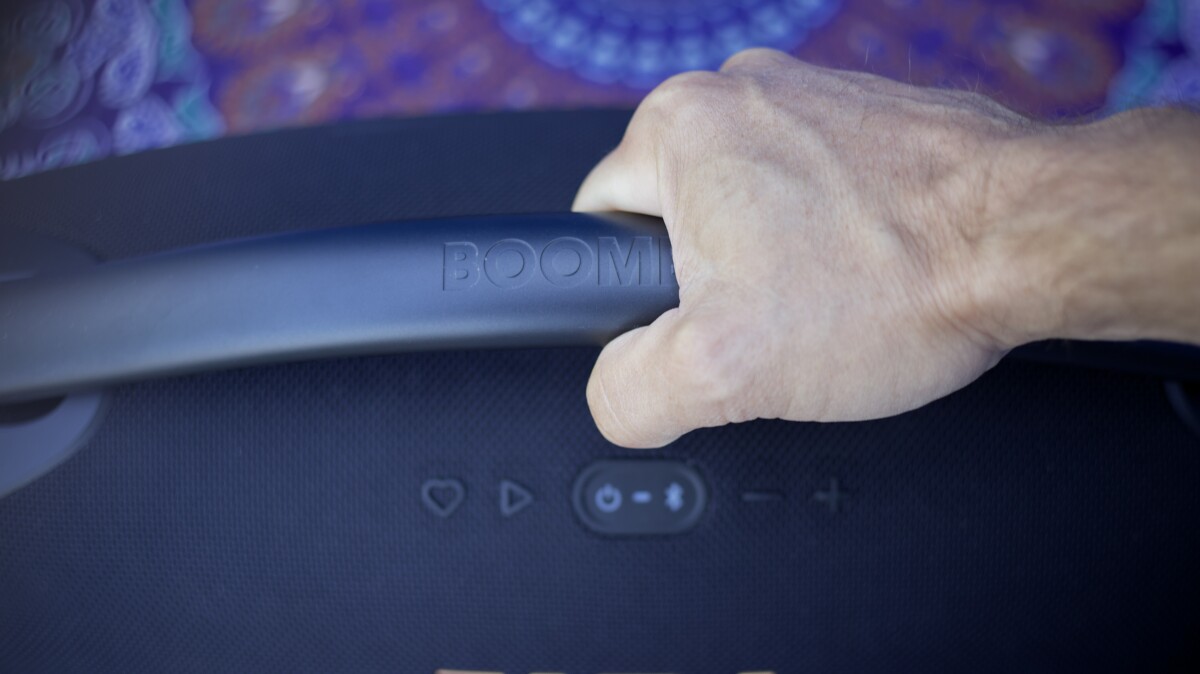
Control buttons include playback, volume, power on/off, Bluetooth activation, and a new heart-shaped button for automatically launching a favorite playlist. The front face houses all the active drivers, as well as a large, embossed JBL logo made of aluminum with a delicate golden hue.

The sides feature two huge passive aluminum radiators, adorned with an exclamation point logo and small waves signifying that the speaker is now WiFi enabled. At the back, hidden under a waterproof cover, there’s the power connector and a USB-A port for charging a smartphone, for example. The USB port can deliver up to 10 W. It’s a pity that it isn’t reversible, which would have allowed for charging the Boombox 3 WiFi away from a power outlet, like with an external battery. Furthermore, JBL has dropped the line input from the classic Boombox 3, and it’s no longer possible to use an analog source (like a portable player) with the Boombox 3 WiFi.
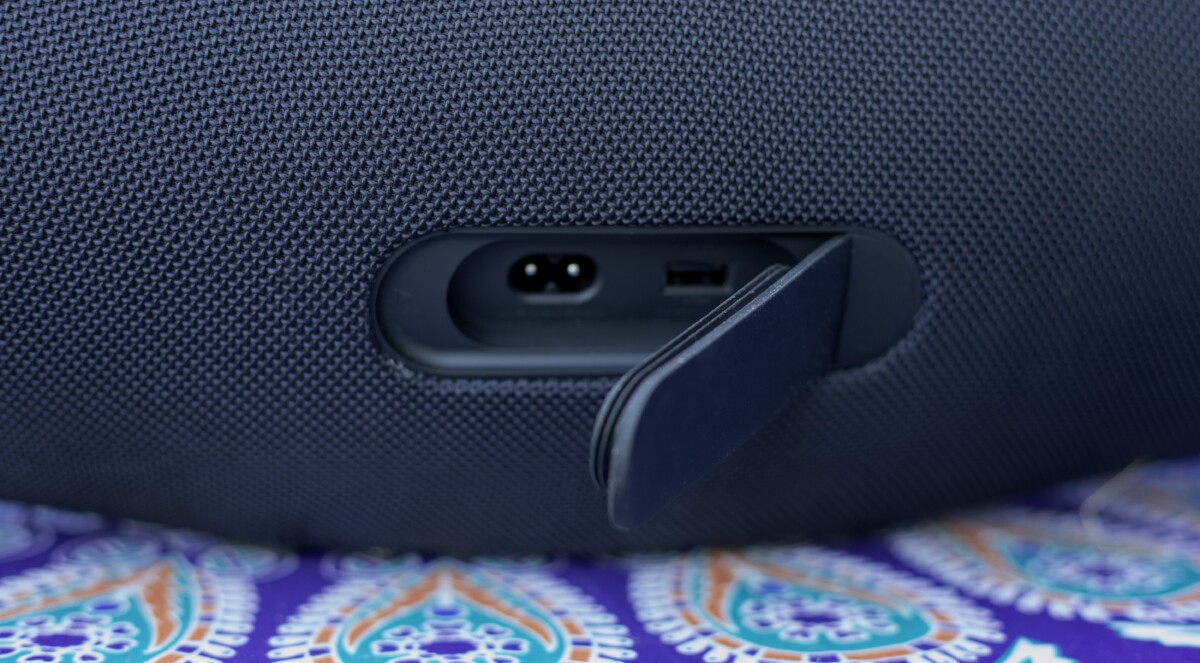
Lastly, a thick rubber foot is located at the base of the speaker, to prevent transmitting vibrations and ensure stability. Weighing in at 6.7 kg, it’s safe to say that once placed, the Boombox 3 WiFi isn’t likely to roll away.
Internal Design of the Boombox 3 WiFi
The JBL Boombox 3 WiFi is a 3-way speaker, separately outputting each frequency range (bass, midrange, and treble) through distinct groups of drivers. This technique, widely used in hi-fi, allows for finer sound reproduction and delivers more details than using one or two drivers.
The Boombox 3 WiFi is thus the only JBL portable speaker to incorporate a real subwoofer, animated by a central transducer (19 x 11 cm) assisted by two massive lateral passive radiators (12 cm diameter). For reference, passive radiators improve the extension of bass sounds and increase their intensity.
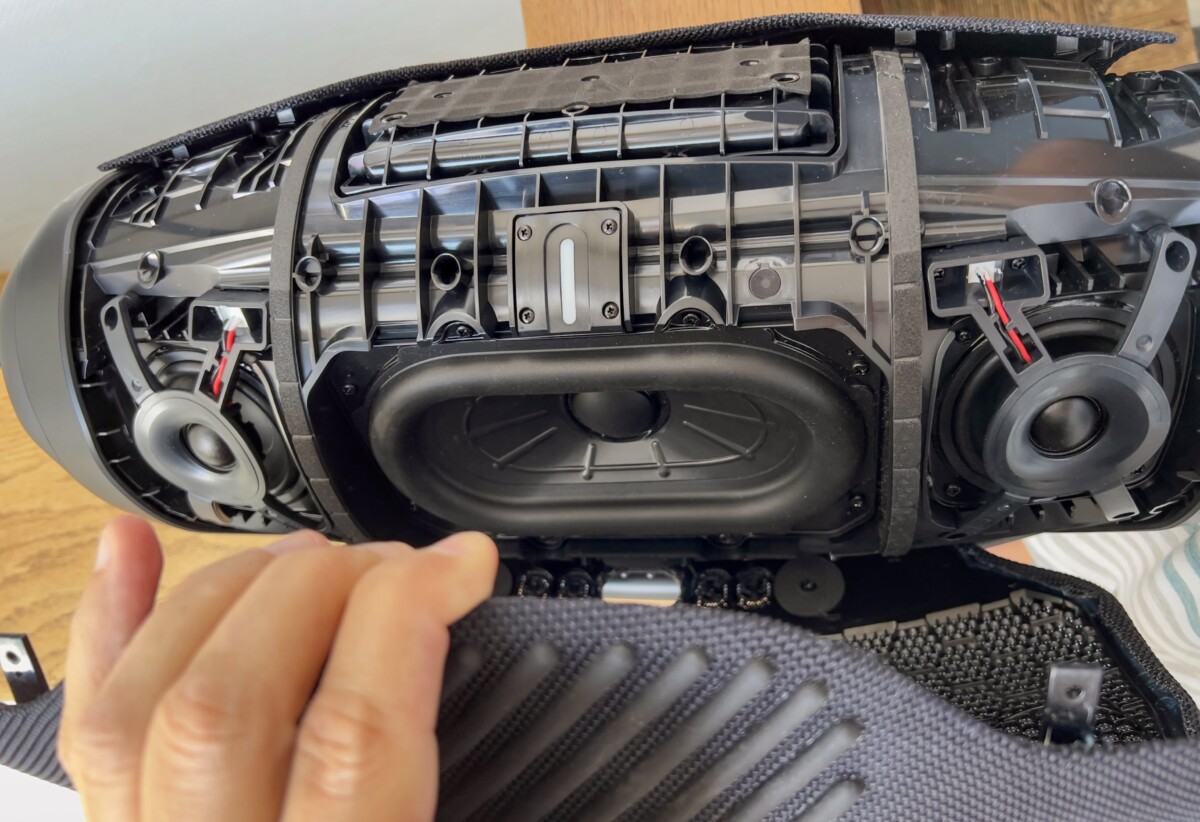
The midrange sounds are entrusted to a pair of circular transducers (8 cm), located on either side of the front face. Unlike other JBL speakers, they don’t reproduce bass sounds, thus they are much faster and more nuanced in the reproduction of midrange sounds (voice, strings…).
Lastly, a pair of dome tweeters (2 cm) handle the highest sounds. These tweeters are positioned in front of the 8 cm transducers, in a coaxial setup theoretically favoring greater spatial precision. We’ll return to this. Finally, each speaker is associated with dedicated amplification, capable of delivering up to 80 Watts for the subwoofer, 2 x 40 Watts for the main transducers, and 2 x 10 Watts for the tweeters. These power levels are significant and seem consistent with the speaker’s claims (playing loud and balanced).
JBL Boombox 3 Wi-Fi: Usage and Application
The Boombox 3 Wi-Fi isn’t as portable as smaller speakers like the JBL Flip 6, which can easily slip into a bag for spontaneous music listening opportunities. Weighing 6.7 kg and with its size, the Boombox 3 Wi-Fi requires some muscle power, a factor worth considering. However, once in place, this speaker is truly a delight to use. Its rubber buttons are molded to represent their functions (triangle for play, + and – for volume…), so they can be easily identified even with eyes closed – a very handy feature.
Good news, the aluminum handle, although black, warms up reasonably in the sunlight. After four hours of beach time under the June sun, it doesn’t burn when moved. The only complaint regarding user comfort is the non-disable power-on melody. As of now, JBL has indicated an upcoming update to correct this issue.
Lossless Audio and Multiroom Capabilities via Wi-Fi
The JBL Boombox 3 Wi-Fi remains a Bluetooth speaker and can indeed be used away from any Wi-Fi network. However, it behaves slightly differently from other JBL speakers as it takes about ten seconds to be ready to play any sound, evidently, the time required for loading a heavier software.
The Bluetooth reconnection management has evolved and by default, the Boombox does not automatically reconnect to the last device; one must either press the Bluetooth button on the speaker or activate the option in the app. Moreover, the PartyBoost mode, allowing simultaneous broadcasting on multiple JBL speakers, is no longer available.
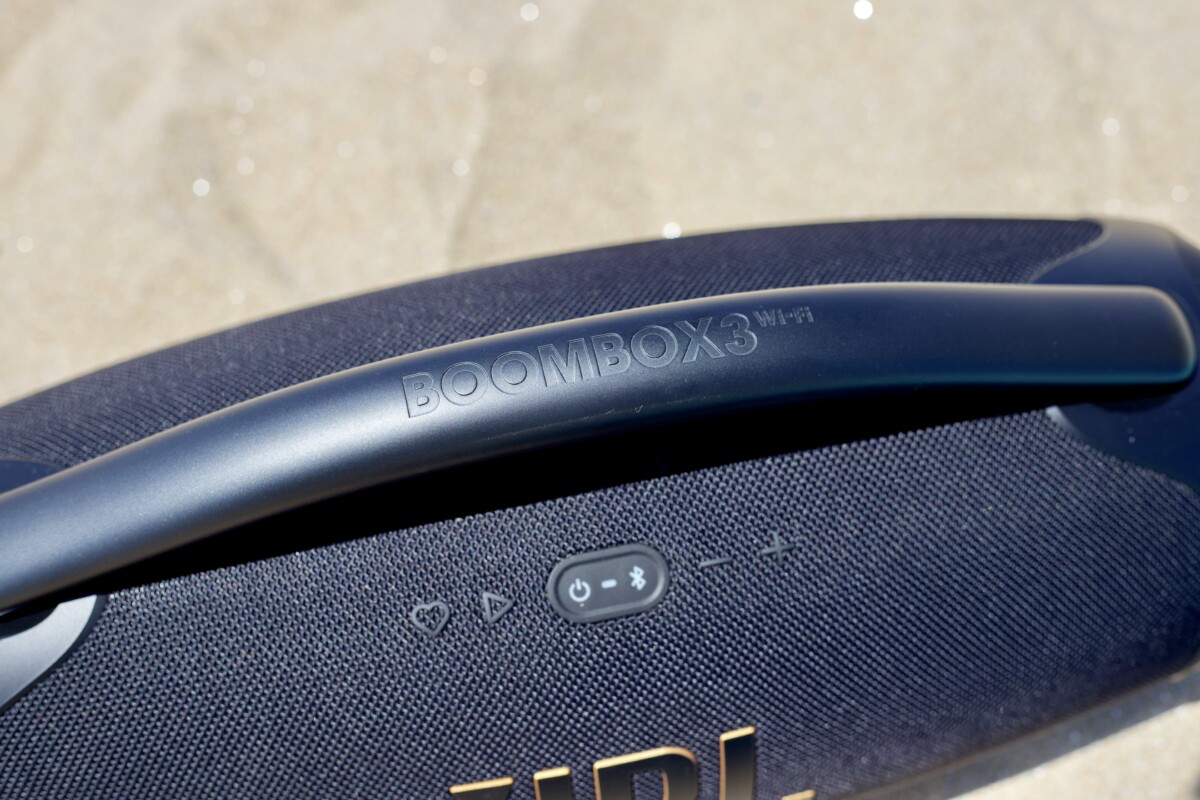
With Wi-Fi, the Boombox becomes compatible with streaming protocols like AirPlay, Chromecast, Spotify Connect, and Alexa Multiroom. Consequently, music can be transmitted to the speaker without compression, unlike Bluetooth – a significant improvement, especially if subscribed to a service offering CD or HD quality streaming (Apple Music, Amazon Music, Deezer, Tidal, or Qobuz).
Furthermore, the Boombox 3 Wi-Fi can be integrated into a Wi-Fi home speaker network using the AirPlay grouping function from an iOS device or Alexa Multiroom on Android. This allows playing the same music on multiple speakers, even from different brands.
The JBL Boombox 3 Wi-Fi can be used as a residential speaker, but it’s worth noting that it will automatically turn off after a period of inactivity, whether it’s running on battery or power supply, with no way of waking it up through the network by playing a track. This is a bit of a shame as the speaker does have a network standby mode and only consumes 1.8 W, which is less than Sonos speakers, for example. A firmware update to prevent the speaker from turning off when connected to power supply would be beneficial.
New Control App
The JBL One app (not JBL Portable anymore) now provides access to the speaker’s advanced features. It includes a 3-band equalizer and a new function named “Moment”, which allows adding a radio station or a chosen playlist, then start playback simply by pressing the heart-shaped button on the speaker. The supported services are limited to Tidal, Amazon Music, Qobuz, Tune In or Napster; for Deezer, Spotify or Apple Music, the function cannot be used, at least for now.
Please note, the “Moment” button only works when the speaker is connected to the Internet via Wi-Fi.
Dolby Atmos Compatibility
Another novelty is the support for the immersive audio format Dolby Atmos, but only from Tidal (with a Hi-Fi Plus subscription). It’s a pity for subscribers to Apple Music or Amazon Music, which also offer many titles in this immersive audio format. Without support for the Tidal Connect protocol or pending a possible update, Dolby Atmos playback isn’t possible from the Tidal app. However, it’s possible under degraded conditions as the native app streams the Dolby Atmos 2.0 version of the tracks and not the 7.1 version with sound objects, resulting in a significant difference in rendering.
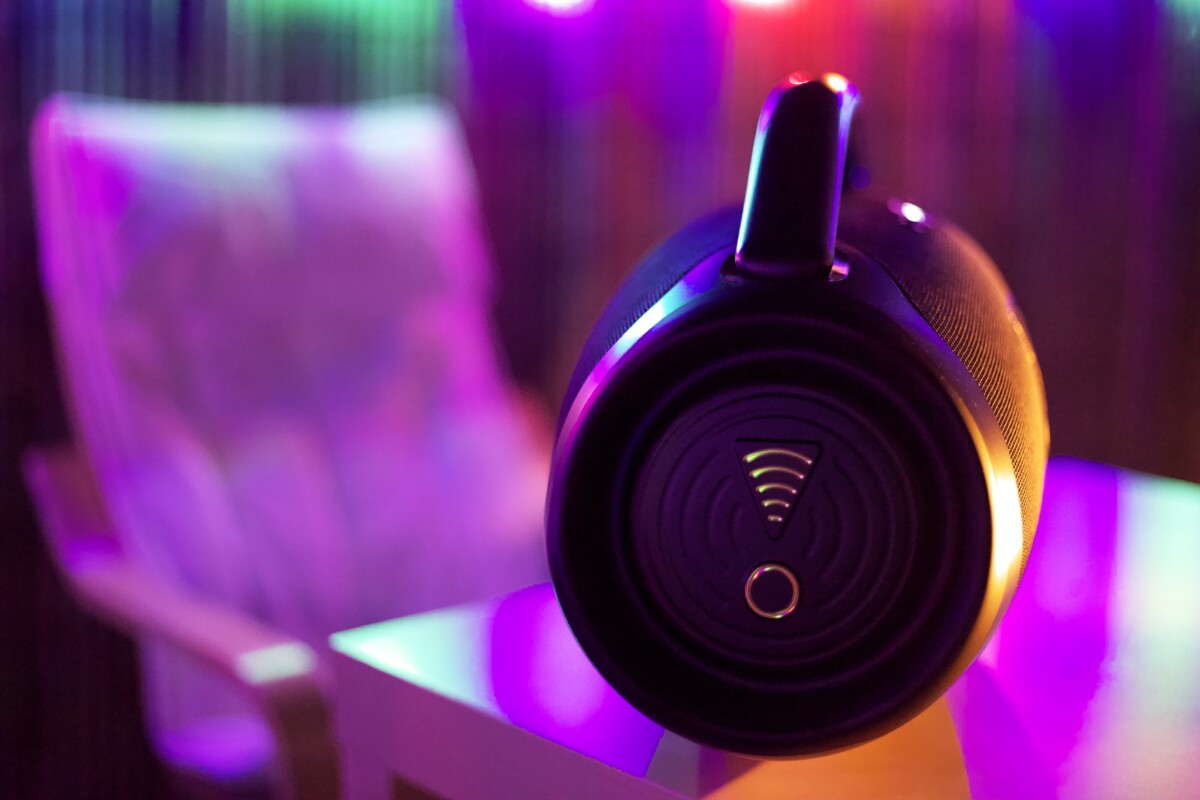
To enjoy Dolby Atmos 7.1, it is necessary to register your Tidal account in the JBL One app and launch playback from your favorites or playlists. More on this later, but Dolby Atmos on this Boombox 3 Wi-Fi is surprising, and many soundbars could take inspiration from it. As of now, the Boombox 3 Wi-Fi is the speaker that offers the best musical experience in Dolby Atmos, even outperforming the Sonos Era 300 due to its excellent voice clarity and centering. Note that to enjoy Dolby Atmos, connection to a Wi-Fi network and the Internet is necessary as Bluetooth does not allow the transmission of multichannel streams and spatial metadata.
Multipoint Bluetooth
The Bluetooth connection is the only usable option when away from home, with Wi-Fi requiring an intermediate access point between the speaker and the smartphone. The Bluetooth connection is excellent, with the JBL Boombox 3 Wi-Fi showing signs of weakness only beyond 10 meters.
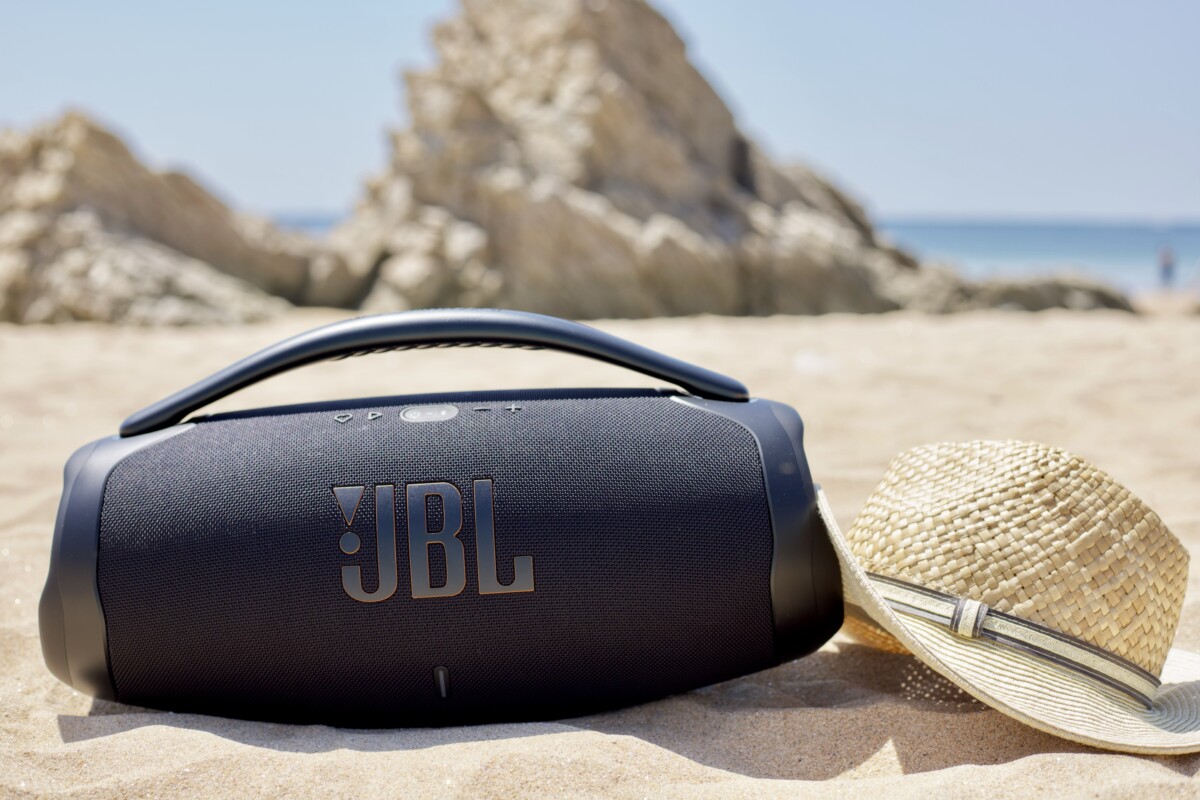
Only the SBC codec is supported, but this is negligible as the quality of a speaker depends on its transducers and amplification. No aptX or LDAC, but as we will see later, this is not a problem. Finally, for gaming purposes, one will have to cope with a sound delay on the image of about one second, which is a very noticeable desynchronization for video games. In video playback, image and sound are perfectly synchronized.
JBL Boombox 3 Wi-Fi Audio Review
The name Boombox might seem apt when we consider the primary target audience – the party crowd. However, it undermines the true capabilities of this speaker. The Boombox 3 Wi-Fi is a genuine hi-fi speaker that is suitable not only for a living room setting for jazz or classical music but also on the beach, blaring dance, rap, pop, or rock with decibel-rattling beats.
Sound Signature
I tested the Boombox 3 Wi-Fi with an iPhone using Bluetooth and Wi-Fi, streaming music from Apple Music and Tidal for Dolby Atmos tracks. I took it to different locations: office, living room, kitchen, terrace, garden, park, and beach. Differences between Bluetooth (SBC) streaming and Wi-Fi (lossless) are not fundamental: the bass is a bit firmer, and the treble is a bit more precise, but you need a discerning ear to notice.
Boombox 3 Wi-Fi delivers the most powerful and balanced sound from JBL’s range of portable speakers. Even at low volumes, the speaker produces a soft and full-bodied sound, maintaining an excellent tonal balance. Notably, the bass register knows when to be discreet and exuberant only when the played track demands it.
- Bass: Perfect extension and impressive hold even at high volume, with moderate dragging and good articulation
- Mid-range: Surgical precision, benefiting almost everything in this range: voices, strings, brass… and controlled acidity at very high volumes.
- Treble: Soft and well integrated into the mid-range, it always brings breathability and depth to the ensemble.
Frequency Response Curve
The Boombox 3 Wi-Fi is large to generate deep and realistic bass frequencies — in other words, pleasant.
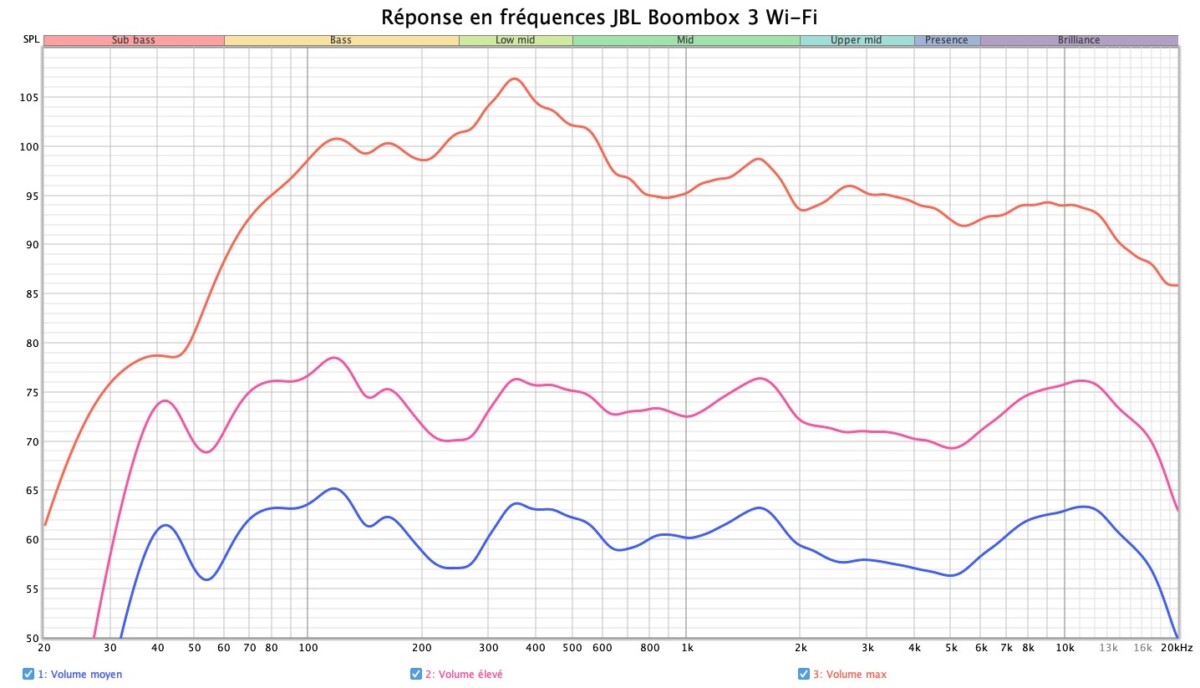
Based on my measurements, JBL has sized the passive radiators to flirt with 40 Hz, a frequency that gives real depth to the sound. The remainder of the curve is well-crafted, with a burst of energy around 100 Hz, ideal for adding impact to percussions, then a plateau from 300 to 600 Hz to underline voices.
A significant and visible peak between 1 and 2 kHz makes the sound overall clearer and sharper, followed by a depression from 2 to 4 kHz to avoid any hardness (our ear is very sensitive here). Lastly, the bump in the treble adds relief and seems boosted outdoors, for clearer and more intelligible sound in a noisy environment.
Dynamic Performance
The Boombox 3 Wi-Fi respects the variations in music intensity and often surprises the listener (without startling them). It has incredible energy, but it doesn’t overdo it.
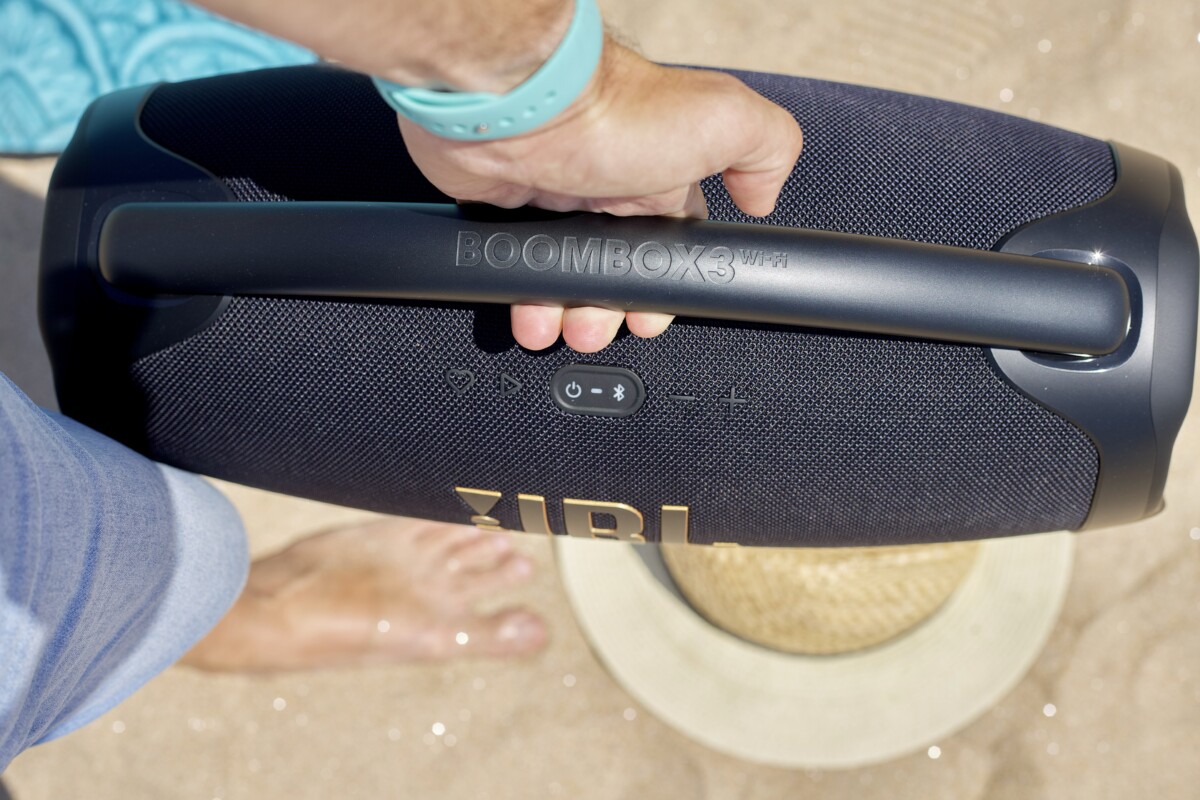
Dolby Atmos Experience
Subscribers to Tidal can take advantage of Dolby Atmos support and won’t be disappointed. The Boombox 3 Wi-Fi manages to position sounds on the sides of the listener and even gives a slightly vertical dimension to the music. The feature that strikes the most when listening to Atmos tracks is the centered and generous voices, which easily emerge from the different sound layers.
A Remarkably Airy Sound Stage
The JBL Boombox 3 Wi-Fi is a genuine front-facing stereo speaker. Rather than sending sound in every direction, it is rigorously positioned. However, the sound stage’s width is limited by the enclosure’s dimensions; expecting the breadth provided by two speakers spread several meters apart would be unrealistic. Nevertheless, the sound is significantly broader than with compact speakers, like Xtreme 3 or Charge 5, for example.
Moreover, the dynamic behavior of the transducers is very good, allowing perceptible ventilation between different sound planes, thus presenting numerous micro-details. Another highlight is the extraction of voices from the music, impeccably centered.
A Pretty Awesome Dolby Atmos Experience
Subscribers to Tidal will be able to enjoy Dolby Atmos support and won’t be disappointed. JBL is rather discreet about this immersive format’s support, even though its listening experience is highly enjoyable. The Boombox 3 Wi-Fi manages to position sounds to the sides of the listener and even adds a slightly vertical dimension to the music.
The most striking aspect when listening to Atmos tracks are the centered and generous voices that emerge effortlessly from different sound layers. On some tracks, the scene suddenly widens or deepens significantly more than with simple stereo broadcasting, sometimes with instrument or voice movements in space. The appeal of Dolby Atmos on this Boombox 3 Wi-Fi quickly becomes evident.

Songs like “Bad Guy” by Billie Eilish, which feels compressed in stereo, blossoms in Atmos and throws plenty of elements (choirs, synths) to the lateral extremities, with a pleasing dynamic. Similarly, “Heathens” by 21 Pilots creates a sound bubble, with floating choirs and synthetic voices that surge and envelop while the singer’s voice remains well-centered and clear. There are many pleasant surprises with the Boombox 3 Wi-Fi, especially when re-listening to Gainsbourg, whose work benefited from a Dolby Atmos remix, to hear voices and instruments like never before.
JBL Boombox 3 Wi-Fi Battery Life
Speaking of autonomy, the Boombox 3 Wi-Fi has a larger battery than the Boombox 3 Bluetooth (9600 mAh vs. 7200 mAh) to compensate for the increased power consumption of the Wi-Fi controller. Therefore, the announced autonomy is still 24 hours.
At 50% volume on my iPhone using Bluetooth, the speaker lasted a little over 26 hours, with a playlist mixing jazz, pop, rock, and rap. Reasonably, one can count on an autonomy of about 10 hours at 80% of the volume, which means with a very high sound intensity to “set the mood” for a nature aperitif with friends.
JBL Boombox 3 Wi-Fi Price
The JBL Boombox 3 Wi-Fi is available in black only at a price of $399. A high price, but the promises of powerful and quality sound are kept, with the added bonus of excellent Dolby Atmos rendering.
Our Opinion on The JBL Boombox 3 Wi-Fi
Design
The JBL Boombox 3 Wi-Fi is very enjoyable to use and is very seriously assembled (resistant fabric, aluminum hoop, and passive radiators…). The IP67 certification protects it from dust and water immersion. However, with almost 7 kg, you will have to fetch it from the bottom of the pool. This substantial weight is related to the quality of the integrated speakers.
Software
This is the only criterion where the Boombox 3 Wi-Fi does not entirely satisfy its user. Its startup music cannot be deactivated, and chaining several speakers in Bluetooth is no longer possible. Also missing are the Tidal Connect protocol and support for Dolby Atmos from Apple Music and Amazon Music.
Battery Life
The advertised 24-hour autonomy is respected and even exceeded, provided the volume is maintained below 50%. The Boombox 3 Wi-Fi then already plays loudly. Beyond that, expect a drastic reduction in operating time, as amplification will consume up to ten times more. It’s a pity that recharging cannot be done with an external USB battery.
Audio
The hierarchy is respected, the JBL Boombox 3 Wi-Fi easily surpasses the already excellent performance of the Xtreme 3. This is not so much due to the additional Wi-Fi connection, but to the use of a 3-way audio system and even more efficient transducers. The sound signature is very pleasant, and the speaker’s dynamic capabilities make you want to tap your foot, if not dance. Outdoors, it can make itself heard despite ambient noise. Finally, Dolby Atmos is remarkably well managed and offers an even wider scene.
Editor’s Verdict
The JBL Boombox 3 Wi-Fi is undoubtedly a great speaker that perfectly fulfills its contract with a powerful and robust sound to party outdoors or at home, with a day’s autonomy.
Impressive in the bass, incisive with voices and instruments without ever assaulting the ear, it deploys treasures of sweetness in the treble and is just as comfortable on pop or rap as on classical or jazz. Its widely motorized transducers — the explanation for its high weight — served by ultra-responsive amplification give it an unexpected refinement on a product designed for off-roading.
And what about Dolby Atmos, barely highlighted by JBL? Its integration is amazing for a purely frontal diffusing speaker; some sounds are placed behind the listener and sometimes even above them. In short, this JBL Boombox 3 Wi-Fi is a brilliant success.
Pros of JBL Boombox 3 Wi-Fi
- Refined sound signature
- Dynamic behavior and sense of rhythm
- Maximum sound volume
- Amazing Dolby Atmos!
- AirPlay, Chromecast and Spotify Connect
- Battery that lasts the entire day (Bluetooth)
- USB-A port to recharge a smartphone
- Premium build quality and IP67
- Can serve as a weight
Cons of JBL Boombox 3 Wi-Fi
- Non-disableable startup sound
- Tidal Connect not supported
- Dolby Atmos not supported from Apple Music or Amazon Music
- Chaining of several speakers now impossible in Bluetooth
- A bit pricey

